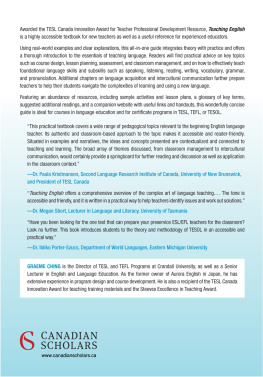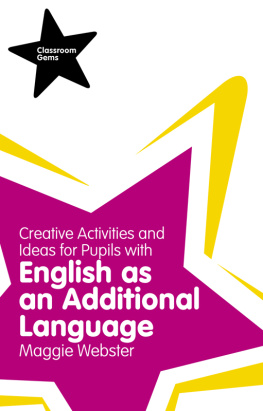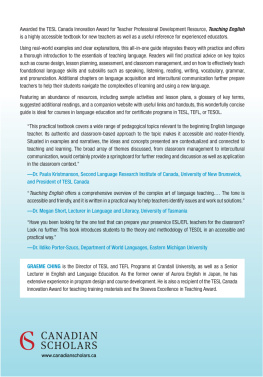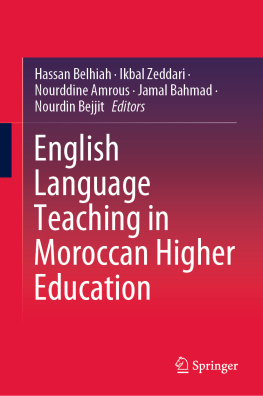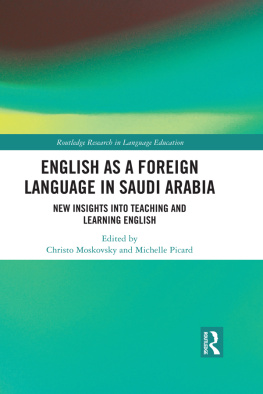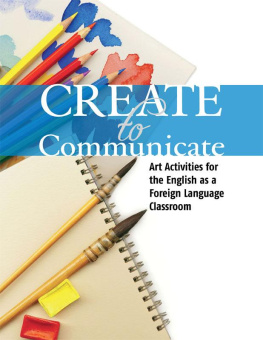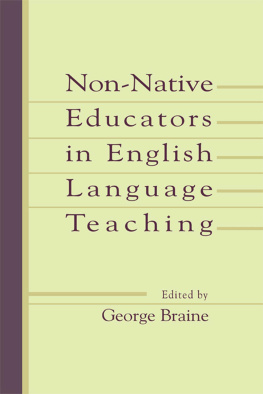Michael P. Berman - English Language Teaching Matters
Here you can read online Michael P. Berman - English Language Teaching Matters full text of the book (entire story) in english for free. Download pdf and epub, get meaning, cover and reviews about this ebook. year: 2011, publisher: John Hunt Publishing, genre: Religion. Description of the work, (preface) as well as reviews are available. Best literature library LitArk.com created for fans of good reading and offers a wide selection of genres:
Romance novel
Science fiction
Adventure
Detective
Science
History
Home and family
Prose
Art
Politics
Computer
Non-fiction
Religion
Business
Children
Humor
Choose a favorite category and find really read worthwhile books. Enjoy immersion in the world of imagination, feel the emotions of the characters or learn something new for yourself, make an fascinating discovery.

- Book:English Language Teaching Matters
- Author:
- Publisher:John Hunt Publishing
- Genre:
- Year:2011
- Rating:3 / 5
- Favourites:Add to favourites
- Your mark:
- 60
- 1
- 2
- 3
- 4
- 5
English Language Teaching Matters: summary, description and annotation
We offer to read an annotation, description, summary or preface (depends on what the author of the book "English Language Teaching Matters" wrote himself). If you haven't found the necessary information about the book — write in the comments, we will try to find it.
A treasure chest of resources and ideas for English Language teachers, both in the UK and overseas
English Language Teaching Matters — read online for free the complete book (whole text) full work
Below is the text of the book, divided by pages. System saving the place of the last page read, allows you to conveniently read the book "English Language Teaching Matters" online for free, without having to search again every time where you left off. Put a bookmark, and you can go to the page where you finished reading at any time.
Font size:
Interval:
Bookmark:
Away, the photo on the front cover, is of a painting by Maka Batiashvili, an artist from the Republic of Georgia. The photo of The Gift in the Chapter on Intrapersonal Intelligence is also by the same artist. To see more of her work, please visit www.maka.batiashvili.net
If any copyright holders have been inadvertently overlooked, and for those copyright holders that all possible efforts have been made to contact but without success, the author will be pleased to make the necessary arrangements at the first opportunity.
by Wayne Rimmer
Many of the contributions in this volume are testimony to the power of storytelling. What should be clear from the range and variety of stories offered is that there is something for everyone in a storytelling methodology. Younger learners are no exception. Beginning with the routine of bedtime stories and going on to the study of serious literature at school, stories are a crucial part of a childs cognitive and socio-cultural development. There may be the objection that children are reading less in this technological age, that stories cannot compete with the attractions of a 24 hour 3D video culture. However, the fact is that technology provides an even greater stimulus to childrens imagination. Modern children are surrounded by information and their natural curiosity for knowledge makes them incredibly receptive to channels for sorting and filtering that information. In other words this is the perfect context for storytelling, as stories, whether fables or jokes, are surely the oldest and most tested way of making sense of a world which has always seemed bizarre and confusing at any stage of human evolution.
Stories then need little justification in the young learner classroom. Young learner covers a wide age-range. There are many pre-school children studying English who will probably go on to study English right through their period of compulsory education, and beyond. ELT coursebooks and resource materials are very coy about giving target age-groups, for marketing reasons, but the consensus seems to be that a young learner is someone who has not finished school yet. There are many storytelling materials available for young learners. For example, books for pre-school children often come with video stories and even puppet characters. Curiously, the primary age-group, ages up to 11 years old, is much better-served than teenagers. True, much adult material could be used successfully with teenagers (there are many examples in this volume) but the mainstream publishers have not done much to target teenagers specifically. Below are three speculative reasons for this with their rationale.
1. Teenagers are not interested in stories anymore.
Adolescents are keen to distance themselves from children and do not want any association with what are seen as childhood interests. The worse thing for any teenager is to be seen to be childish. In other words, stories are not cool enough.
2. It is too difficult to find stories which appeal to teenagers.
The teenage period is associated with tremendous physiological and mental changes. There is also a great deal of peer pressure and crises of confidence, stoked up by advertising and the popular media. These forces make the teenage market unstable in that teenagers tastes and preferences are constantly changing as they desperately seek a fresh identity. In this atmosphere, it is nigh near impossible to predict which stories will work.
3. Teenagers should concentrate on formal language study or exam preparation.
We live in an age which demands accountability. On the oftcited premise that we tend to value what we can measure, syllabi and tests stress discrete language points so that knowledge can be compared and ultimately judged. Teenagers are not exempt from this process and school curricula typically place great emphasis on formal assessment. There is simply no time and place for methodologies which do not offer quantifiable learning goals.
These points do generalise the issues, for instance, it is not true that formal assessment precludes storytelling. Even some public exams, e.g. the Cambridge ESOL Certificate of Advanced English, include a set book option, which encourages the study and enjoyment of narrative. However, the three points do relate to real concerns, so they are addressed in turn.
1. Teenagers are not interested in stories anymore.
There are stories and stories. Teenagers will not react well to anything perceived as childish but they will enjoy a tale they can relate to. A classic example is urban legends, those bizarre and whacky stories of alligators in the New York subways, Kentucky fried rats, etc. Teenagers love this mix of the grisly and implausible because it highlights the many contradictions in their own lives. The trick is to find the right story, which leads to the next point.
2. It is too difficult to find stories which appeal to teenagers.
Who is doing the finding? If it is a middle-aged teacher who hates teenage classes, or, worse, the writer of a global coursebook trying to make the book as commercially successful in as many countries as possible, the chances are that the story selected will lack resonance. As the class teacher, you are in a much stronger position to target your teenagers needs. Its your class so get to know them and what stories they like. Even better, get your teenagers to bring in or make their own stories. As a simple example, for homework, ask each teenager to come to class with a joke in English.
3. Teenagers should concentrate on formal language study or exam preparation.
Stories offer an extended and authentic context for presenting, practicing and producing new language. As shown in the second activity below, it is easy to teach grammar through stories. In fact, stories are an ideal vehicle for language work because they personalise the target language so effectively. The trick is to make the goals transparent to students, and parents: Were listening to this story because we need to practise more prepositions. If you have a very tight syllabus to deliver you may try to tell yourself that you do not have time for stories. Think again because almost certainly the converse is true - you do not have time not to tell stories.
The proof of the pudding is in the eating so below are two sample storytelling activities for teenagers. However, as said above, the real skill in telling stories to teenagers is to select material and tasks which suit their needs and interests. This is more work for you than asking the learners to go to page 73 in the coursebook but teenagers will definitely appreciate the effort you make and respond accordingly. As any teacher of teenagers knows, the highs and lows of teaching this age-group are extreme, but the right story massively increases the chance of a very positive learning experience.
Level: B1 +
Topic: fairy-tale
Language focus: mixed
Skills focus: listening, speaking, sentence writing
Time: 60 minutes
Procedure
Learners complete names quiz in pairs.
Go through the answers in class and surprise learners by giving Rumpelstiltskin as an answer for question 5.
Tell the story using the story skeleton: use gesture, intonation and drama to enhance the meaning. Remind learners before you begin telling the story that they will have to listen carefully as there are comprehension questions afterwards. (It takes learners a few minutes usually to realize that the questions are nothing to do with the story as told!)
Learners complete the questions individually and then ask each other.
Questions 9, 10, 11 are extra silly questions for learners to come up with: the sillier, the better.
Font size:
Interval:
Bookmark:
Similar books «English Language Teaching Matters»
Look at similar books to English Language Teaching Matters. We have selected literature similar in name and meaning in the hope of providing readers with more options to find new, interesting, not yet read works.
Discussion, reviews of the book English Language Teaching Matters and just readers' own opinions. Leave your comments, write what you think about the work, its meaning or the main characters. Specify what exactly you liked and what you didn't like, and why you think so.

